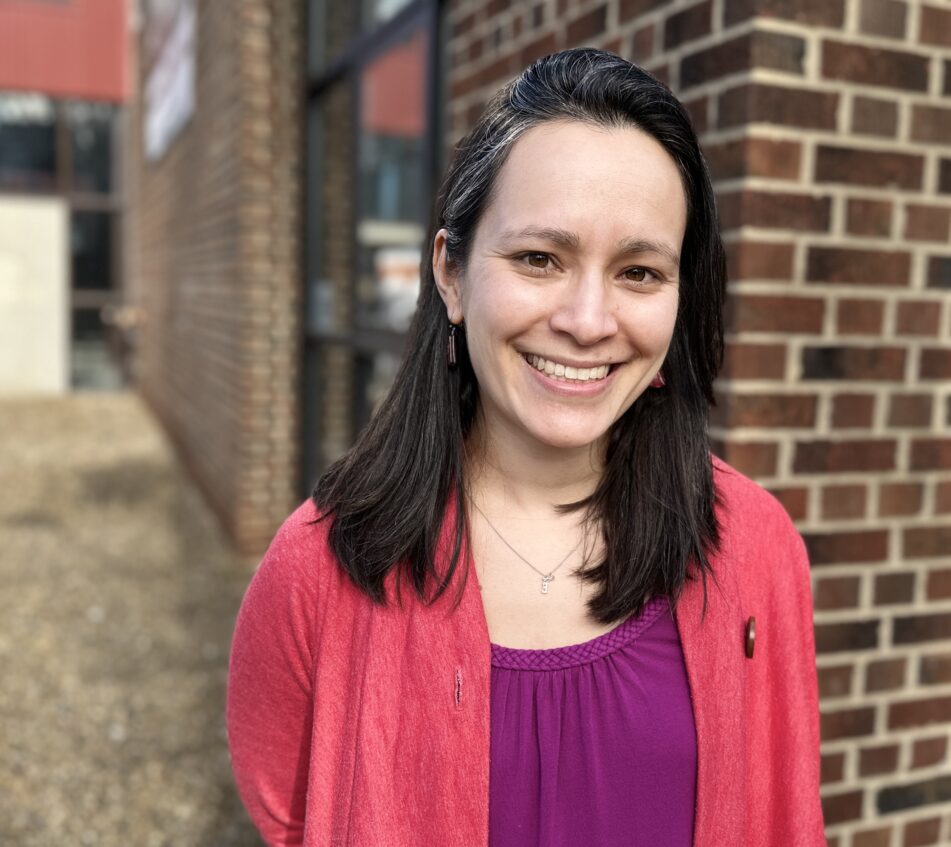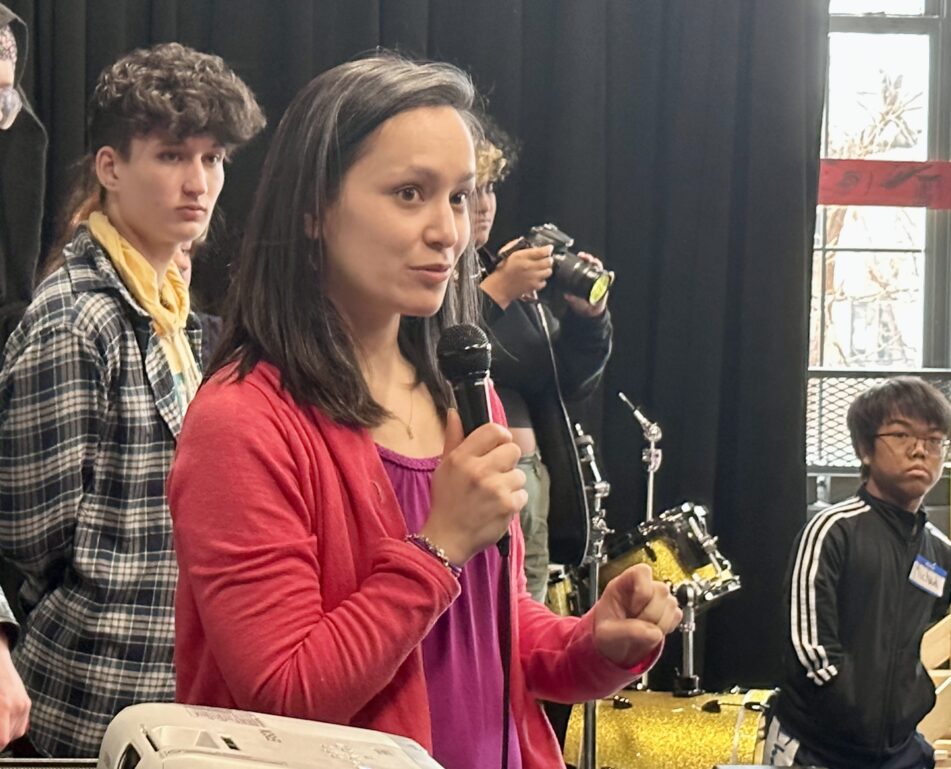

Joslyn Hunscher-Young grew up in Ann Arbor, attending Wines, Forsythe, Pioneer, and Community before going on to Swarthmore College and the University of Michigan. After a year-long fellowship at Research for Action in Philadelphia and a year teaching at an international school in Shanghai, China, she returned to Michigan. Hunscher-Young taught at Washtenaw International High School and Middle Academy before joining the staff at Community High School in 2020.
Hunscher-Young lives in Ann Arbor with her family and loves cooking, gardening, and planning adventures.
How do you feel about the district’s emphasis on dignity this school year?
I hope and trust that the district’s focus on dignity was at the forefront during contract negotiations because one key way to create a culture of dignity for staff is to recognize our worth as expert professionals.
What classes do you teach, and which is your favorite and why?
I currently teach History of Racism and Resistance in the U.S., World History and Geography, and Forum. I also monitor Community Resource courses (CRs). There is something particularly wonderful about each of these that I love, so it is hard to pick a favorite. I love the focus on developing skills to better understand our global society throughout World History and Geography. The long-term relationships we develop in Forum are unique and powerful. Monitoring CRs allows me to see how students from across the district are pursuing their learning passions. The new course, History of Racism and Resistance in the
U.S., is exciting because of the topic and the final local history research project we’ll do.

Can you elaborate on this new class—History of Racism and Resistance in the U.S.—that you are developing?
The class is being piloted at all five in-person high schools in AAPS this semester or third trimester. The focus is on helping students to understand both how racism has been established in American society throughout our history and, importantly, how people have always been resisting this oppression throughout history, too. All of us who are teaching the course are particularly excited about the local history research projects that we’ll do with students at the end of the course because it allows students to really engage in the historical process. We’ll be investigating a core question, digging into historical materials and interviewing local experts, and making and communicating a clear and thoughtful answer to the question.
For example, at CHS we will be focusing this work on understanding the impact of the closing of Jones School and how desegregation in AAPS impacted our community, especially the Black and African American community in Ann Arbor. I picked this to help align with our school’s theme year focus, Hidden Histories: 100 Years of Jones School and Black Ann Arbor.
What inspired you to become a teacher?
I always loved learning, and I see teaching as a way to work toward meaningful change in our community. When I was in high school, AAPS still had the SEED (Students Educating Each Other About Discrimination) program, and in that program, there was one activity we did that illustrated the power of supporting even just one other person to go out and make a change in the world. Since then, I’ve really seen teaching as a way to help my students recognize the power they have to improve the world around them. I hope that my role as a teacher encourages students and helps to amplify their voices for change.
When you recall your first year of teaching, what memories stand out?
My first year of teaching was at an international school in Shanghai, so most of my memories are about cultural differences in how teachers are shown respect, how fire drills are conducted, and how the lunchroom smells and feels.
What advice would you give to a first-year teacher?
Breathe, sleep, and don’t be afraid to ask for help and make mistakes.
What was your very first job?
My first unofficial job was as a cat sitter for neighbors, but my first job where I paid taxes was working at the front desk of the Ann Arbor Y.
In your three years in AAPS, what’s the most important thing you’ve learned about teaching?
About learning?
In my three years in AAPS, I’ve been reminded constantly of the resilience, persistence, and dedication of teachers and learners. All of us – teachers, students, and families – had to learn how to adapt to online school, hybrid school, and the “new normal” of school life during a global pandemic. Through all of this, teachers have constantly been adapting their lessons and methodologies to ensure students learn. Families have been navigating and supporting this learning and the physical and mental health of everyone involved, and students have been resilient in building relationships, skills, and support for one another. So, I guess the thing that stands out to me most in these last few years is that we are resilient and able to thrive because of the support we give to one another in our community.
What’s the happiest part of your day?
I love dinner with my family each night. We share good food and share something that we liked about our days, which helps me—and them—to feel connected and reflective.
What would surprise people about Community High?
Community is a place that encourages students—and staff—to figure out what they’re passionate about learning and then supports them in pursuing that learning. It’s why I’ve been able to start new elective courses like African American Studies (2021-2022), History of Racism and Resistance in the U.S. (2022-2023), and Asian/Pacific Islander American Studies (hopefully in 2022-2023). It’s why we have students taking CRs in specific topics at the University of Michigan but also in woodworking, radio broadcasting, and biomedical research lab work. I find this to be true as a teacher now and also found it to be powerful
when I was a student at CHS many years ago.
What were you like as a Community High School student, and did your time there affect the way you teach today?
I didn’t get into CHS until I was a junior, so I split enrolled at Pioneer and Community my first two years and then still took Spanish at Pioneer as a junior. I think, as a student, I was a kind of athlete-nerd, if that makes sense. I loved the CR program that allowed me to take some courses at the University of Michigan and work in a small group with a professor for an additional Spanish class when I was a senior. I still played field hockey under the direction of the fabulous Jane Nixon at Pioneer.
I think my time as a student at CHS does inform the way I teach now. I believe that high school students need and deserve the responsibility of being young adults. This influences the ways I approach things like independent work time and open-ended projects with students. I still provide ideas, scaffolding, and support for students, but I leave it up to them to decide when, where, and how to work on their independent assignments. This requires a solid foundation of relationships between the teacher and students, which I try to build and definitely felt as a student at CHS many years ago, too.
I also think that CHS has been – and still is – very much a place for people to figure out what they’re passionate about learning and then it supports them in doing that learning. I felt that as a student, and now I still feel that as I am supported to work on developing these new courses and learning Opportunities like our work around the history of Jones School.
What is the most rewarding part of teaching?
The most rewarding part of teaching is when I get to actually see the impact of learning on my students. It’s like when a student tells me they’re considering studying African American Studies in college because of how my course piqued their interest or when I see one of my typically quiet forumites lead our group check-in for the first time. It’s when a CR student makes dramatic improvement from their first midterm exam in a college course to the second one because they’ve realized how to navigate office hours and get help from their graduate student instructor. It’s having our students start a club to continue coordinating events about the centennial anniversary of Jones School because they want to help others learn about the local Black history of our building.”
The rewarding part of teaching is seeing the growth and development of young people who I know are going to continue to make our world a better place.
Joslyn Hunscher-Young
How do you recharge?
Sleeping, reading, baking, gardening, and taking walks with my family.
How do you spend your summers?
Right now my summers mostly involve “Mom Camp” with my kindergartener daughters. We currently have plans to for this summer that include learning more about dogs, volcanoes, and famous women throughout history and also having a “Bus Adventure” week where work on our map skills to navigate the city and figure out how to get to different places throughout the Ann Arbor-Ypsilanti area each day.
I’m also applying to some summer institutes for teachers through the National Endowment for the Humanities. This year, the two I will apply to focus on understanding aspects of Asian/Pacific Islander American history, so if I am accepted into either of these, I will also participate in a one-week intensive institute and use that knowledge to inform my teaching in AAPS in the coming year.
What’s most exciting about your professional life right now?
I’m really excited about the work CHS staff and students are doing this year to honor and recognize the legacy of Jones School and Black Ann Arbor In addition to local history walking tours, lunch and learn events with guest speakers of local organizations and local Black/African American elders, and features in our student-run newspaper, “The Communicator,” we’re also working to get a permanent historical marker. We have currently raised just over $20,000 since last June, and we’re hoping to get at least $10,000 more to create this large marker recognizing Jones School and the Black/African American community in what is now the Kerrytown neighborhood of Ann Arbor. It’s exciting to see our students and staff engage in this learning together, and I think it can serve as a great launching point for our whole district to do more work at understanding our local history at all grade levels.

Be the first to comment